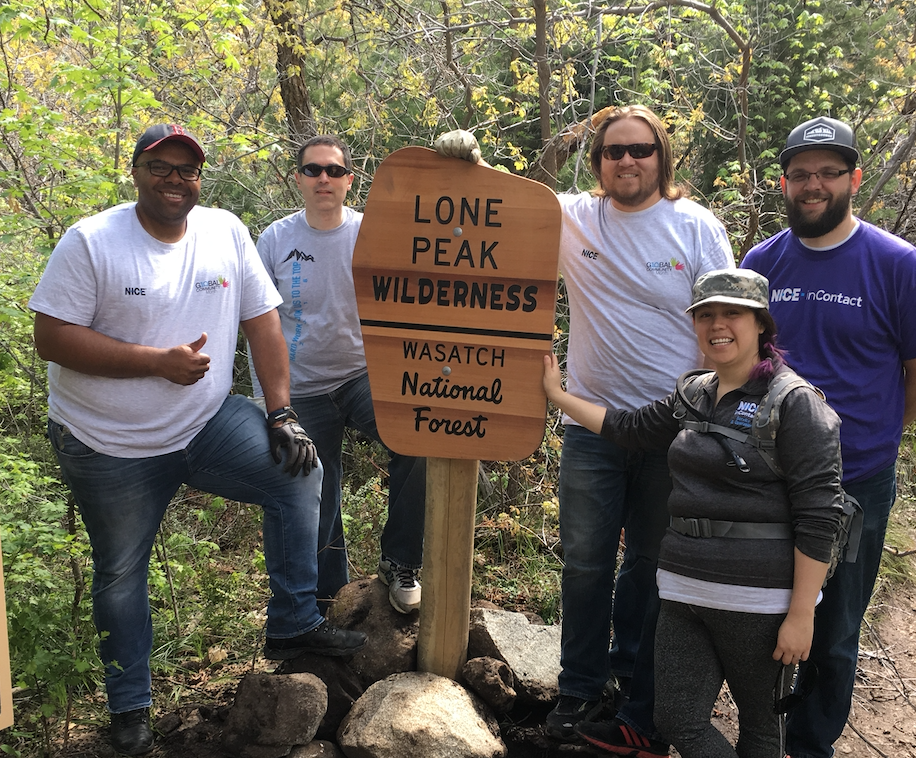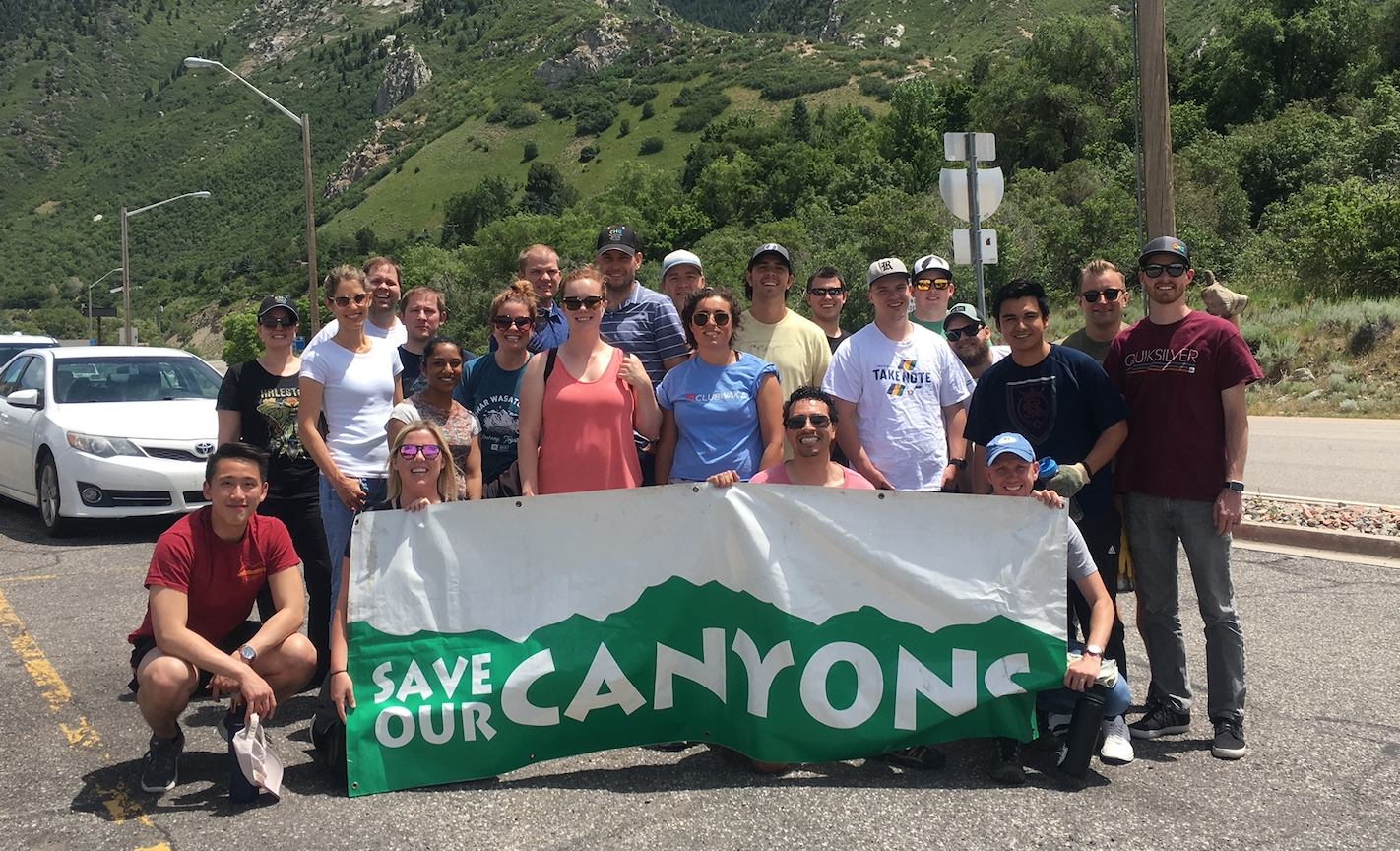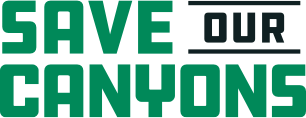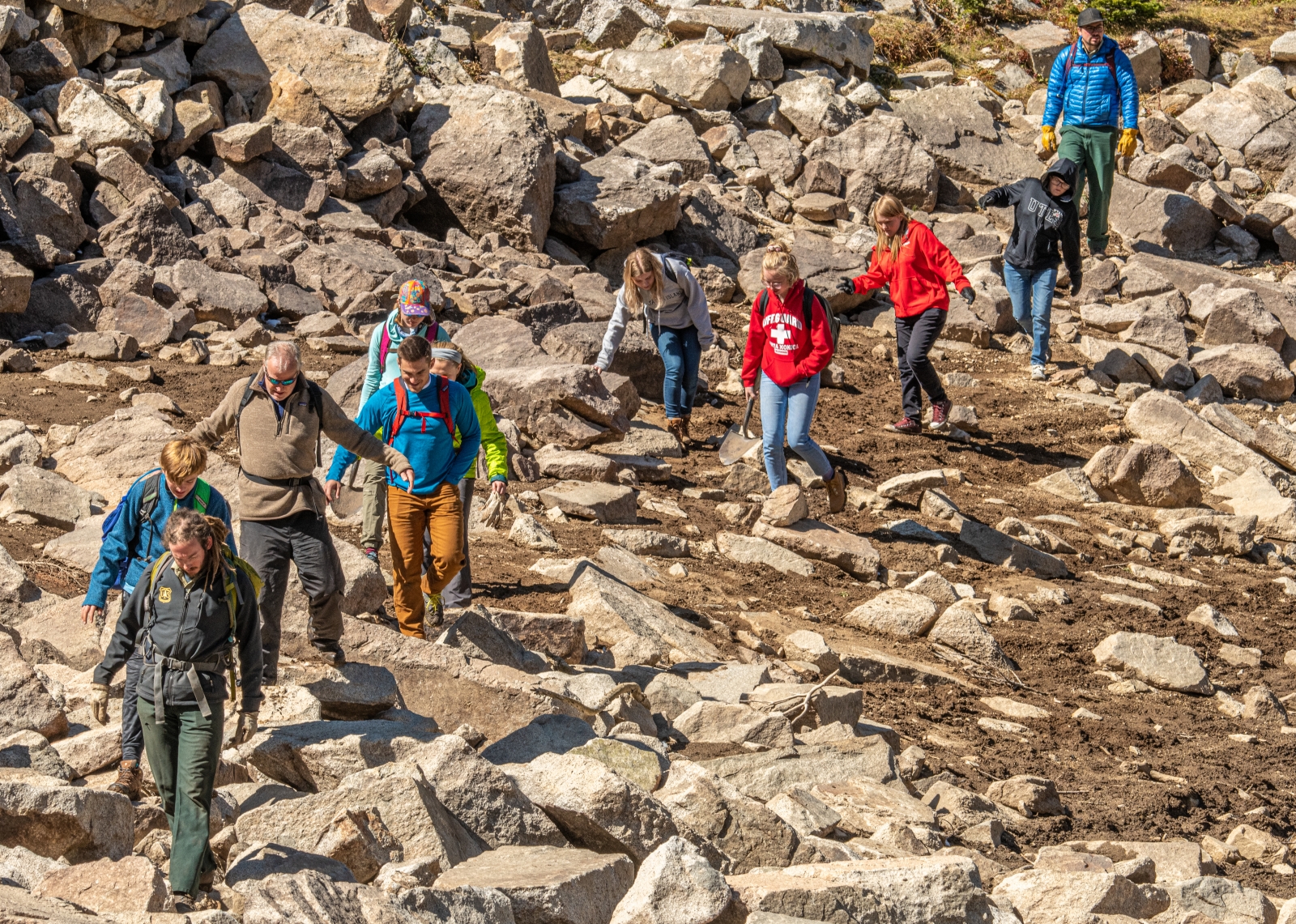For those of you who are reading this, I am Luke Golden. I have held the position of Education and Stewardship Coordinator at Save Our Canyons for the past year and a half. It has been my pleasure to lead the Wilderness Stewardship Project as well as our other volunteer opportunities and SOCkids. It is my belief that active involvement with our SLC community is critical in order to preserve and protect our beautiful Wasatch Mountains. Growing up in a small mountain town in Northern New Hampshire has helped to shape my views on how to protect and use wild areas that are home to so much flora and fauna.
Another year of our volunteer projects and Wilderness Stewardship Project has come to an end. This year, we turned our time and dedication towards restoration in Lone Peak Wilderness, installation of new wilderness signs within four different wilderness areas, and five trash clean up days in Big Cottonwood Canyon. For everyone who is not familiar with the Wilderness Stewardship Project (WSP), this is a project that is aimed at improving wilderness areas in the Central Wasatch through trail maintenance and restoration, while focusing on educating the public about these areas. In 2018, Save Our Canyons, with help from the David Kelby Johnson Memorial Foundation, launched an effort to promote volunteerism, educate and engage students, and improve stewardship within the designated wilderness areas in the Central Wasatch Mountains.
We started off the 2019 season with a bang! Our first WSP volunteer events of the year started in late May, when we installed six signs in four different wilderness areas. Over the winter, Save Our Canyons received a grant from the National Wilderness Stewardship Alliance that gave us the funding to purchase six wilderness portal signs for the Salt Lake Ranger District to be installed in Lone Peak, Twin Peaks, Mount Olympus, and Deseret Peak Wilderness Areas. We installed these wilderness portal signs from May 28-31st with the help of Nice InContact volunteers for each volunteer sign installation day. Installing these wilderness portal signs was no day in the park by any sense. Each sign that we installed required four volunteers to carry the eight foot long and six inch wide post up the trail to the old portal sign. Once we carried all the materials to the old portal sign, we dug out the old one and installed the new one.
After replacing a couple of the signs, it became clear that the crew who installed these old signs 20 years prior did not follow the forest service guidelines for installing trail signs. This was evident because some posts were only one foot in the ground, some maybe two feet, others with no nails in the bottom of the post to keep it secure (deadmaning) and others were not properly buried. The Forest Service Requires sign posts to be dug three feet deep into the ground, to be deadmaned, and to be buried in a particular way that requires the layering of rocks and gravel with the hopes that these signs can direct hikers for 20 years or so. We successfully removed and installed every wilderness sign. These wilderness sign installation days were well worth it when the newly purchased signs were installed and the old falling apart signs retired from their duty of informing hikers about these unique areas. Many thanks go out to all of those who volunteered.

We know that the majority of the trash in the Cottonwood Canyons is not in the wilderness areas, but along the roadside. To improve the water and environment of the Central Wasatch Mountains we set up five volunteer days to pick up trash in Big Cottonwood Canyon. We would like to thank CHG Healthcare for participating in four out of five volunteer days and The Grauer School of Encinitas, California for contacting SOC to set up the fifth. We were able to cover seven miles of Big Cottonwood Canyon while picking up 21 garbage bags full of trash. Each day as we picked up trash in BCC, it became clear that different areas of the canyon accumulated more trash than other spots. Not surprisingly, the areas with the highest amount of trash are at the base of the canyon, Butler to Mineral Fork, Mill D North/Reynolds Flat area, outside Spruces Campground area, and outside Solitude Ski Area — which see a lot of use. There are other areas in the canyon that could use a clean-up as well, but we expect to get to those next summer. We accomplished a lot but were unable to clean the entire Big Cottonwood Canyon Highway due to the all the other volunteer projects that we had going this summer. Also Save Our Canyons is a small five person operation. We are all busy with different projects and campaigns that we believe are worthwhile and can bring positive change to the Wasatch. If we are able to increase our funding towards projects like WSP or trash picks, we would be able to accomplish even more.
It was a pleasure working with the students from The Grauer School because I was able to provide their first experience in the Wasatch Mountains. Many of them had questions about the snow, animals, environment, and why the water that flows through these mountains is important. I was pleased to hear from some of the students that they perform trash pick-ups at the local beaches near their homes. They noticed that a lot of the trash we were finding was similar to what they find on the beaches, but that there was much more on the coast they reported that each day new trash lines the beaches. One of the teachers said that the beach in California could use it every day and that we in a way were lucky because the trash does not replace itself at the same rate that it does in the ocean. Even though our mountains might receive a lesser amount of trash, any is too much. It is of the utmost importance that all who enter and enjoy these mountains are thoughtful and considerate and contribute to keeping them pristine. These areas are not our homes, but the homes of the native plants and animals. When we are in the mountains, we are merely visitors.

As summer came into full swing, our traditional Wilderness Stewardship Project began on June 15th with the focus on the Lone Peak Wilderness. Bells Canyon Trail was our first overused and unappreciated trail of this season. For this event, we cleared five water drainages, cut brush, and closed seven user made trails. As we were hiking up the trail, we noticed one thing that stood out quickly; the group size. We saw numerous groups hiking within the Lone Peak Wilderness that exceeded 20 plus people. Designated wilderness areas have group size limits to reduce the impact on the area and the group size on the Salt Lake Ranger District of Lone Peak Wilderness is 10 people. I strongly encourage anyone who hikes to get informed in the rules of the area the area that they choose. The rules exist for good reasons. Save Our Canyons has created a variety of opportunities to learn about the wilderness rules. We developed a wilderness education plan to educate the valley about wilderness areas in hopes that people recreating in these areas have a minimal impact. This education plan consists of web pages that are linked to our website, brochures that present the importance of these areas, their rules and how you can recreate in ways that are not detrimental to these areas. If you are interested in improving your knowledge or sharing the information about wilderness areas, you are more than welcome to stop by the office and grab some brochures or check it out on the wilderness tab on our website. Brochures are also available at our business partners which include Patagonia, Fisher Brewery, Momentum Gym, Wasatch Touring, Cotopaxi, IME and a couple others around the city.
During the remaining four WSP days, we spent our time focusing our efforts on the Red Pine Lake Trail due to the high use it experiences and also that it was being rerouted this past summer. During these four volunteer days we cleared 20 drainages, cut brush, closed nine user made trails, removed 10 illegal fire pits, and rerouted .2 miles of the Red Ped Pine Lake Trail. We were happy to participate in the lower reroute of the two reroutes on the Red Pine Lake Trail to make it easier for hikers and to improve water drainage off the trail to lessen the impacts of erosion. The Salt Lake Ranger District, with the help of other local districts, The Cottonwood Canyons Foundation, and the community came together to accomplish this. The reroute was beautifully done and I suggest that everyone take a stroll up this trail to see all the work that was done by people who care for these areas. While we were rerouting the trail, many hikers commented on the new trail, mentioning that it is much easier and that the reroute was beautiful and was well done.
One of my favorite parts about the Wilderness Stewardship Project is meeting the volunteers and listening to the stories they have about the Wasatch and how it has changed. I enjoy hearing about their experiences hiking throughout the world and in Utah, and why they were inspired to volunteer with Save Our Canyons. One common theme is that every volunteer shares an appreciation of the Wasatch and has a darn good story to share as well. Our experiences in the mountains, whether in the Wasatch or another range, shape us to be outdoor enthusiasts and engaged activists. Mountains bring people together and shape the beliefs of communities. When we get together, it’s obvious that we share common goals for the future of these mountains and wilderness areas.
As the WSP season came to a wrap, we had our last volunteer day on October 5th with plans to remove illegal fire pits from Red Pine Lake. As the morning of the 5th arrived, I drove to the Little Cottonwood Park and Ride to meet the volunteers who had contacted me. I was expecting a usual turn out of 5-7 volunteers who were ready to dedicate their Saturday to improving our wilderness areas. But as I waited outside my car on this chilly fall morning, volunteers started to arrive. A few volunteers arrived, but to my surprise, the stream continued until my car was surrounded with people of all ages ready to conquer the Red Pine Lake Trail one more time. An astonishing 18 volunteers came out to show their appreciation and dedication on our last day of the year.
Previously, our highest turn out over the 12 WSP volunteer days over two years was 8 volunteers. It warmed my heart to see the age range of those who came to help out. We had students from local high schools as well as adults in their retirement. High volunteer turn out is an important factor for this project because we are able to cover more ground and spread out the workload. With 18 volunteers we were able to have two groups of nine split up to cover both sides of the lake. Due to it being late in the season, the lake was very low, which uncovered most of the trash that was in the area. It ws sad to see the accumulation of broken glass that was found around and in the lake. It was also discouraging to see how many illegal fire pits were in the area. The Forest Service does not want dead wood to be burned because it provides homes to birds and insects as well provides nutrients to the soil so that plants can grow. The fire rings also scar the earth leaving black stains in our wilderness areas. It is my hope that more and more people each year will educate themselves and others about the Wasatch and how to recreate properly in this area so that we can keep these mountains healthy. I strongly encourage anyone who is interested to stop by our office to pick up informational materials or contact a member at SOC for further education. Over the past two seasons of running this project, I have noticed that it can be challenging to get people to show up to volunteer on their weekends, so it was thrilling to see the support over the course of the summer and especially on our last day. As a result of the volunteers’ efforts, we were able to make a larger restorative impact on the area. I would happily spend any weekend with these dedicated and passionate individuals working on improving the Wasatch.
Over the course of the summer we had 14 volunteer days where we worked with 130 volunteers. Thanks to our passionate group of outdoor enthusiasts, we performed 463 hours of volunteer work in the Wasatch Mountains through trash pick-ups, wilderness trail maintenance/restoration, and wilderness sign installations. Many agencies such as the Forest Service rely on volunteers to help them with projects such as trail maintenance or highway trash pick ups. This summer we saved the Forest Service and UDOT a combine $11,774.09 though our service hours to clean up and maintain the Central Wasatch Mountains.
I would like to thank everyone involved in helping to restore our Wasatch Mountains to what they should be. I encourage everyone to share their stories with friends and family about your time volunteering with Save Our Canyons because it is our hope that we can attract even more volunteers next year. It is our mission to keep these areas clean and with your help we believe we can continue to keep the Wasatch pristine.



